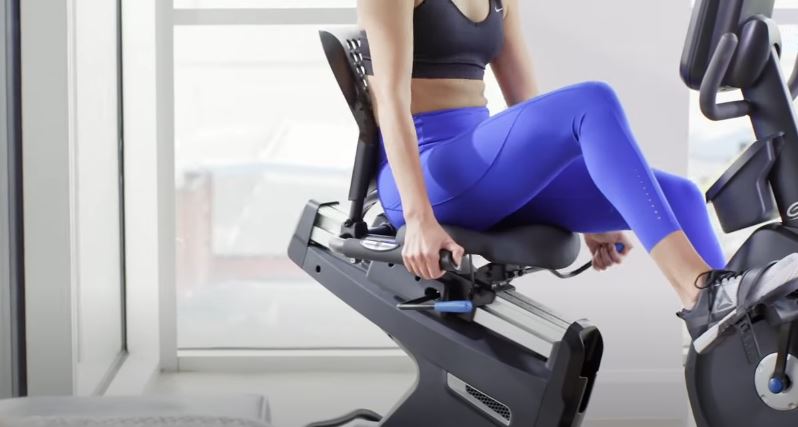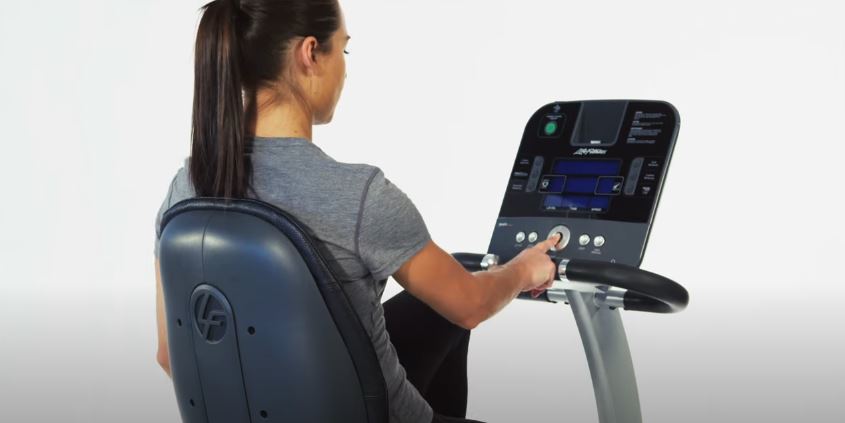Riding a recumbent bike may seem easy, but there are some important considerations to gain the full benefits of an effective workout.
In the following section, we list 10 ways you can make the most of your recumbent bike for an effective workout.

- 1. Adjust Your Seat Correctly
- 2. Stretch It Out Completely
- 3. Warm Up Before You Begin the Workout
- 4. Maintain Proper Form
- 5. Choose the Right Resistance
- 6. Alternate Speed with Resistance
- 7. Select the Appropriate Duration
- 8. Keep Busy While Cycling
- 9. Cool Down to End the Session
- 10. Keep Track of Your Progress
- A Quick 20-Minute Recumbent Bike Workout You Can Try
- Final Thoughts
1. Adjust Your Seat Correctly
One of the most common mistakes when using a recumbent bike is not adjusting the bike’s seat. Make sure that your knee’s position on the downward pedal stroke has a slight bend.
It will only take a few minutes to adjust your seat accordingly. Making this little adjustment on your seat will increase the effectiveness of your workout. So check if your seat is properly adjusted before doing your exercise.
2. Stretch It Out Completely
Stretching before any type of workout, such as riding a recumbent bike, is very important to loosen up your muscles and tendons. Stretching prior to training will increase your flexibility and range of motion, thus will improve your overall performance during your exercise.
Spend a few minutes performing dynamic stretches, including leg swings, trunk rotations, toe touches, ankle touches, high steps, and lunges.
While doing the dynamic stretches, pay attention to moving smoothly and slowly intensifying your range of motion on each repetition.
3. Warm Up Before You Begin the Workout
After you have stretched out completely, spend some time pedalling lightly on your recumbent bike. Warming up increases blood flow and temperature to help prepare your cardiovascular system for the workout.
Here are two easy ways to warm up before a recumbent bike workout:
• Walking Warm Up
Warming up the muscles you are about to work on is very important to get your blood flowing. Walking or jogging will greatly help in raising your heart rate and getting your legs ready for the workout. Five to ten minutes of brisk walking or easy jogging will help you get your blood pumping and ready for a vigorous workout.
• Pedal Slow
Pedal at a slow pace, then increase speed for about five minutes. You can stand up momentarily before returning to your seat for the actual workout.

4. Maintain Proper Form
Having a proper form minimises the risk of injuries and enhances your performance and efficiency on the bike.
Remember to maintain a straight posture with your back aligned and tight against the seat’s back support.
You can hold the handles during intense cycling but avoid leaning forward. Leaning forward may create imbalances.
5. Choose the Right Resistance
Most people who are new to a recumbent bike have little idea of which resistance level to select.
When starting with a new exercise machine, such as a recumbent bike, be sure to choose a comfortable resistance as you try to understand how to use it. Increasing the resistance means you need to pedal harder.
6. Alternate Speed with Resistance
Vary your pedalling speed while upping the resistance to make your workout more challenging. You can also cycle backwards if you want a more stimulating workout. Recumbent bike workouts are easy to tailor to suit your fitness level and goals.
7. Select the Appropriate Duration
We recommend aiming for at least thirty minutes of cardio workout daily to reap the benefits of a recumbent exercise bike workout.
If you want to lose weight quicker, then you should aim for at least sixty to ninety minutes of cardio exercise a day, five times a week (Frontiers in Cardiovascular Medicine 2018).

8. Keep Busy While Cycling
What’s great about a recumbent bike is that you can do other things while working out. You can read a book or watch your favourite show while training.
Some can even do their work on their computers during their workout sessions. Getting busy while cycling makes time fly. Without you even noticing it, you’re already done with your workout session.
However, do not get distracted by these activities. Make sure you are not decreasing the intensity of your workout. Keep pushing your body to make progress with your workout.
9. Cool Down to End the Session
An easy pedalling cool-down lets the body unwind some processes that were elevated during the workout.
A proper cooling down is an essential step in the post-exercise recovery process.
It only takes a few minutes of stretching and mild variations of the movements you would normally do during the exercise session.
Some of the reasons why you should remind yourself to cool down after riding a recumbent exercise include:
• It regulates your heart rate.
Working out, in general, increases your heart rate after an exercise session. You need to normalise your heart rate after a workout. Do not stop abruptly after riding because you may get lightheaded or dizzy.
• It decreases the build-up of lactic acid.
After a tiring workout, lactic acid forms in our bodies, which can lead to muscle stiffness or cramping. You need to cool down to help accelerate the process of delivering the lactic acids in your body to recover faster.
• It prevents the risk of injuries.
Cooling down also helps in preventing injuries like muscle tears. Missing a cool-down after a workout slows muscle recovery and decreases the benefits of an exercise.
• It aids in body restoration.
When you exercise, your body goes through a lot of changes, such as increased body temperature, faster breathing and adrenaline pumping. Cooling down helps in reestablishing your body to its normal state.
10. Keep Track of Your Progress
Check your activity on the monitor of your recumbent bike so that you can keep track of your progress. Don’t be too comfortable with your routine. Make sure you challenge yourself further each time.

A Quick 20-Minute Recumbent Bike Workout You Can Try
Here’s an interval-based workout you can try at home.
- Start by warming up for five minutes at an easy pace.
- Increase the pedal speed and resistance to perform intense cardio at an eight or nine level of intensity. Perform this for fifteen to thirty seconds.
- Decrease the pedal speed and resistance to a moderate pace for a thirty-second recovery interval.
- Alternate between high and moderate intensity for ten minutes.
- Cool down for five minutes.
You can experiment with different interval times for diversity. You can also use the built-in programs that automatically regulate the pedal resistance and speed.
Final Thoughts
A recumbent bike is an excellent exercise machine for your cardiovascular workouts. It is a great machine for the elderly and people with back problems. Though this machine seems very easy to use, you still need to learn how to use it properly. Knowing the right way to use a recumbent bike is crucial to achieving an effective workout. Keep in mind the tips above to make your workout successful.
Related Questions
1. What recumbent bike is suitable for a beginner?
For beginners, choose a recumbent bike that is easy and comfortable to use. Make sure that the seat is properly cushioned and has all the basic features such as heart rate sensors, a wide, bright LCD screen that displays time, distance, speed, pulse, calories and Bluetooth connectivity. Find out which type of exercise bikes are best for different fitness goals in this post.
2. Which muscle does a recumbent bike work?
A recumbent bike works most of the muscles on your upper and lower legs. However, if your recumbent bike has arm cranks, then it can also work your arm muscles and upper body. It can work the muscles on your glutes, quads, hamstrings, calves and shins, core, biceps and triceps. Read here for a more comprehensive answer.
3. Can you lose weight using a recumbent bike?
Recumbent exercise bikes are one of the easiest and most comfortable ways to gain cardio workouts. It is a great exercise for losing weight, burning calories and developing overall fitness. Aim for at least 60 to 90 minutes of recumbent bike workout for weight loss five times a week. Remember that you need to aim for longer workouts if your goal is to lose weight.
- How Long Should You Stay in a Sauna Safely? - 20 January 2024
- Boost Post-Workout Recovery: Benefits of Using a Sauna for Recovery - 19 January 2024
- Discover the Health Benefits of a Low EMF Infrared Sauna - 19 January 2024
